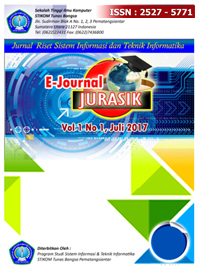Analisis K-Medoids Dalam Pengelompokkan Penduduk Buta Huruf Menurut Provinsi
Abstract
Full Text:
PDFReferences
I. Parlina, A. P. Windarto, A. Wanto, and M. R. Lubis, “Memanfaatkan Algoritma K-Means Dalam Menentukan Pegawai yang Layak Mengikuti Asessment Center,” CESS (Journal Comput. Eng. Syst. Sci., vol. 3, no. 1, pp. 87–93, 2018.
A. P. Windarto, “Implementation of Data Mining on Rice Imports by Major Country of Origin Using Algorithm Using K-Means Clustering Method,” Int. J. Artif. Intell. Res., vol. 1, no. 2, pp. 26–33, 2017.
Sudirman, A. P. Windarto, and A. Wanto, “Data mining tools | rapidminer : K-means method on clustering of rice crops by province as efforts to stabilize food crops in Indonesia,” in IOP Conference Series, 2018, pp. 1–8.
N. A. Widiastuti, S. Santosa, and C. Supriyanto, “Algoritma Klasifikasi Data Mining Naïve Bayes Berbasis Particle SWARM,” J. Pseudocode, vol. 1, no. 1, pp. 11–14, 2014.
D. F. Pramesti, M. T. Furqon, and C. Dewi, “Implementasi Metode K-Medoids Clustering Untuk Pengelompokan Data Potensi Kebakaran Hutan / Lahan Berdasarkan Persebaran Titik Panas ( Hotspot ),” J. Pengemb. Teknol. Inf. dan Ilmu Komput., vol. 1, no. 9, pp. 723–732, 2017.
Z. Mustofa and I. S. Suasana, “Algoritma Clustering K-Medoids Pada E-Government Bidang Information And Communication Technology Dalam Penentuan Status EDGI,” vol. 9, pp. 1–10, 2018.
D. Listiyanti, Y. A. Syahbana, and S. R. Henim, “Perancangan dan Implementasi Aplikasi Android Penentu Salient Area pada Video dengan Algoritma,” in ANNUAL RESEARCH SEMINAR 2016, 2016, vol. 2, no. 1, pp. 96–101.
A. Y. Rofiqi, “Clustering Berita Olahraga Berbahasa Indonesia Menggunakan Metode K-Medoid,” J. Simantec, vol. 6, no. 1, pp. 25–32, 2017.
DOI: http://dx.doi.org/10.30645/senaris.v1i0.78
Refbacks
- There are currently no refbacks.
 








